Once you have done your research, it is time to sort all the words and phrases you selected.
You will find a truckload of data that you need to organize and arrange into some useful information. Start by categorizing the words accordingly as you know your web site topic best, and create some nice Keyword packages. By keyword packages, I mean the list of related keywords that you build. These packages contain the keywords you selected as the main keywords and the search terms related to them.
For example, for a Joomla! web site, you could have main keywords be Joomla! themes, Joomla! components, Joomla! plugins, and so on. Under Joomla! themes you can have the search terms, free Joomla! themes, magazine style Joomla! themes, and Joomla! SEO themes.
If you have imported the list of keywords into an Excel spreadsheet, you can sort most of the terms easily. But you need to do more with this keyword list. Yes, you have built your basic list already, if you followed the steps above and did it for several of your web site keywords.
Now you are getting into the fun part of choosing the right words to target, by using search engines such as Google, Ask, and Yahoo! Who would know better than the sites in which you want to improve your rankings? We will start with ask.com, make sure you use the site's USA version as some of the local ones don't support the options we want to use.
Once you have the site open, type in the keyword you want to check, in our case study example that would be Landscape Gardening. Type slowly and you will see with each character you type, the list of Search Suggestions will change and reflect terms that ask.com thinks are related. Write down the words that you want to use from your keyword list, and start sorting those terms.
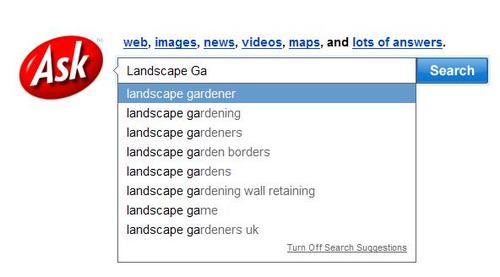
On the search results page there is a column that says Related Searches also. In that column you will see some topic related terms you might want to use later.
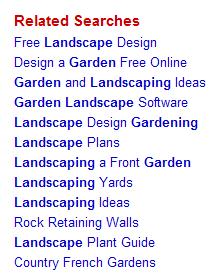
But there is a hidden treasure for you on that site as well—click on the Q&A tab which is in beta, but works fine for your purpose.
Look at the questions asked and their answers. If you have done the first section of this chapter right, you will find several of the keywords from your list in these questions.
Use the answers to your benefit when you start to write your content.
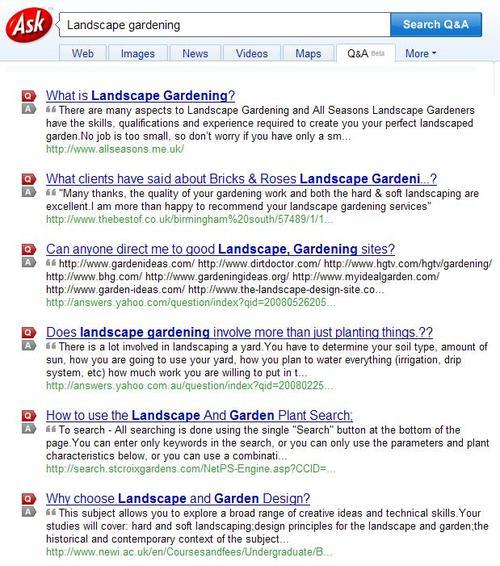
Ok, we are done with ask.com, so let's move on to yahoo.com.
Here you do the same exercise and you see the same thing happening. Don't forget to use the up and down pointers to see more.

Go to the results page and you will see why you really want to check these engines to get more grip on the sorting of your topics.
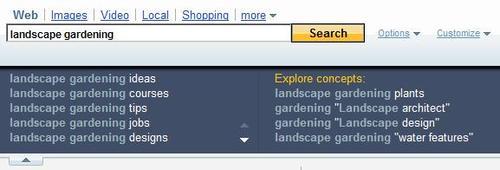
Just look at the wealth of topics and concepts that Yahoo! offers. You can really get into sorting your keywords with this kind of help.
Next stop: Google.
Again you will get a drop-down box with the related search terms:
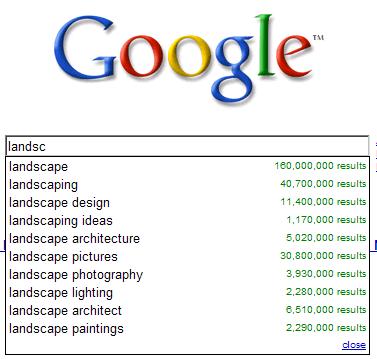
But Google gives you just a little bit more to use. Did you notice the numbers to the right of each search term? Here you can see how difficult it is going to be if you try to rank with those keywords. The numbers reflect the competing results Google has found for you. Remember, I told you we would get into the competing numbers? This is where you can see those numbers right away. As you can see in the previous screenshot that the term landscape has 160,000,000 results, in the following screenshot you see that landscape gardening ideas has only 288,000 results.
Now search for your keywords and get back to your keyword list and check how many searches are done with the terms you picked. But even without a lot of searches, you should quickly get an idea of how to use this extra information for your site. For best results, choose words and phrases that are most likely to have a lot of searches and have less competition.
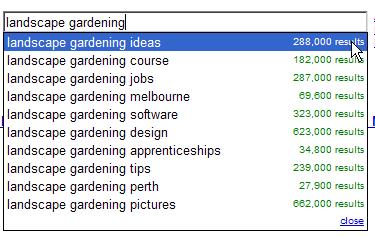
If you are lucky enough to have a broad topic, you will see that Google gives you related searches on your topic at the bottom of the results page.

You are going to use this information later for structuring/restructuring your web site. Write them down on a separate page or spreadsheet, so you don't lose it in the crowd of keywords in your list. Use them again for moving the keywords you have found into topical clusters.
Still not sure how to find the right words?
Here is a simple idea to get you going. Go to a library and find a book about the topic of your web site. You may also visit amazon.com for the same purpose. In this case study, it would be about gardening, landscape gardening, and koi fish. Check the layout of the book and of course the table of content, which will give you some clue about how to structure your keywords.
On amazon.com you might want to check if there are any books that you can LOOK INSIDE They mostly show you the Table of Content, Excerpt, and the Index. Those items should also give you an idea on what terms to put together. You can do one more thing; go to http://www.wiki.org and search for your main topic. You might find some nicely structured pages on it that will point you in new directions to explore. One word of advice: stick to the subject or you may easily get lost or sidetracked on Wiki.
Once you are finished with your research, create a smaller list by reviewing the results you found and put them in an Excel sheet. How did you do? I hope you are learning a lot and still have fun doing it. It has been hard work, but you will see how you are going to use your list and several topics in this book, I promise. Following is the list of keywords for our case study:
Now you need to do something else before you start using your keywords list. You need to know the performance of your site in traffic and its search engine ratings. You should really know how visitors come to your web site and you need to measure and analyze that traffic. You should install these trackers before you start optimizing your site, because you want to make sure:
Therefore, you should use two separate analytic services, so that you can compare results. And make sure you aren't measuring the wrong statistics. The one I always start with is www.statcounter.com. This is because the graphs and numbers are clear and easy to understand, and also you can use it as a hidden counter (many others need an image of some sort), and you can block your own visits from showing up in the results. To get started, go to www.statcounter.com and register for a new account, don't worry, it's free.
Log in to the site, create a new project, and then fill out the form shown in the following screenshot:
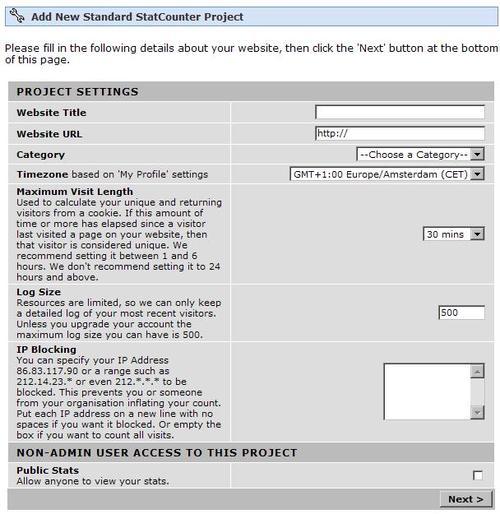
Use the Next option to get to the next screen (shown in the following screenshot) and choose the counter option. I have activated BUTTON ONLY option on the site, but that is just for showing you what counter I use. In your case it might make more sense to use the hidden INVISIBLE COUNTER option.
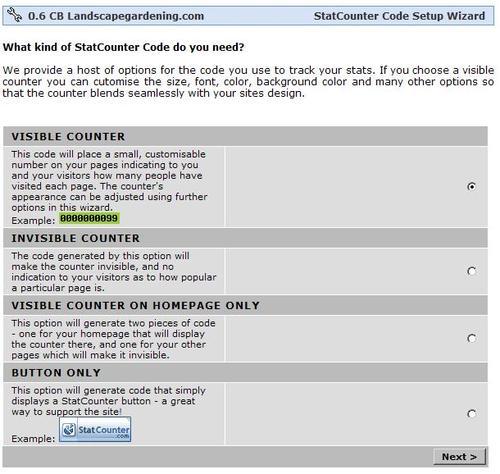
Next is the Installation Options screen, shown in the following screenshot. Leave this as default, as you will use the basic code on your site.
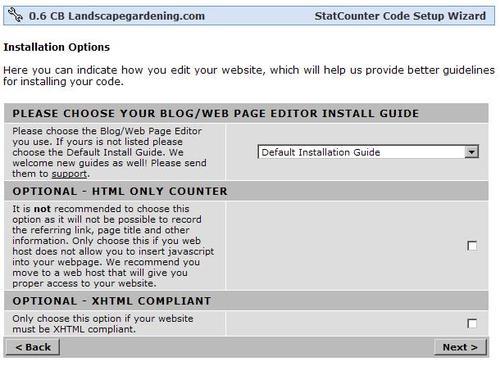
Now you need to copy the code, so just click on it to select the entire code and copy it to the clipboard of your computer. You will get an email from StatCounter which will contain the code as well.
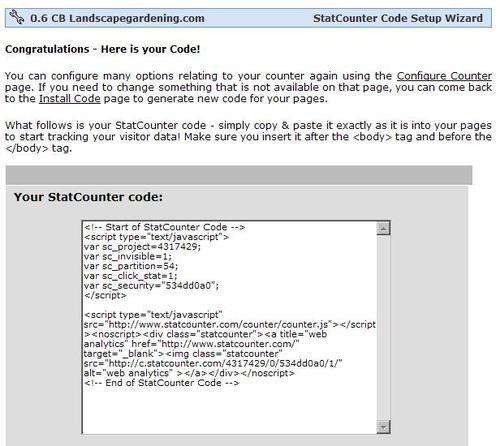
Now you need to get the code into your Joomla! site. Most people will copy the code into the template's HTML code just before the </body> tag. But you don't do this because you want to make sure the code will still work if you change templates or use a different template for another section. You want to set and forget the options to make sure you see all visitor stats all the time.
So how to do that? Joomla! makes it so simple for you. Log in to your admin panel choose the menu item extension and then module manager, and click on the New button in the right side top menu.
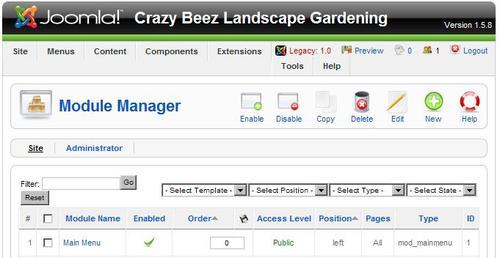
Then select Custom HTML from the list, and paste the StatCounter code into the field below the setting that says Custom Output.
Don't save the module yet, we have to give it a place and set the Show Title option to No. I always set the module to left in the Position menu. You can pick a spot to your liking, but the left side menu is mostly the closest to the </body> code.
Save the module and check the frontend of your site to see if it shows up. If you use the invisible option for StatCounter, you need to check the source code of the page that was generated to see if it is really active. Once you have done that, go back to StatCounter, find the record of your visit, and create a Blocking Cookie under the CONFIGURE option for the counter. Now, your visits from that computer will not be registered anymore. The blocking cookie is a small text file that contains the information StatCounter looks for if you visit the site. If it is there, then your visits are not recorded in the statistics of your site.
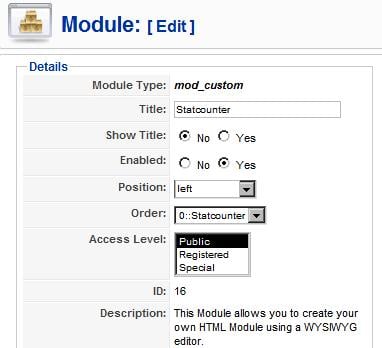
I told you we are going to use two trackers, the second one is being Google Analytics. If you don't have a Gmail account yet, go get one, log in, and activate the Analytics function. You will be using more features of Google for your SEO, so you really need to get an account from www.googlemail.com—it's free.
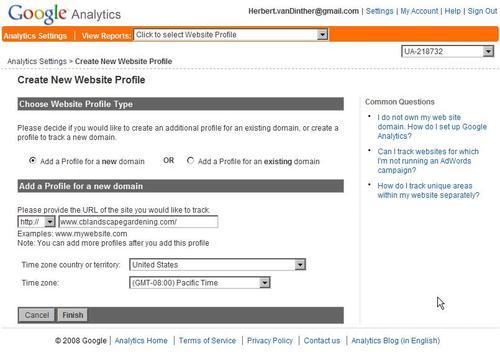
Create a new web site profile for the site you want to track. Copy the new analytics code and paste it below the StatCounter code in the same module, or create a new one the same way as earlier. Once you are ready, click on the Edit button and in the top right corner of that screen it will show a small icon that you have to click on to check if the code is implemented the right way.

Now you should see the following screen:

See the small line where it says Waiting for Data. That means you can come back tomorrow to see if anything has been recorded. Google updates the data every 24 hours so you cannot track your visitors in real time as StatCounter does.
All done? Then lets move forward and start with the use of your keyword list.



